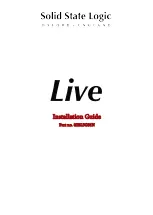
SSL Live Installation Information
Page 4 of 45
Maintenance: Dust Guards
Your Live Console may be fitted with dust guards covering the air vents beneath the faders. It is
recommended that the filter foam should be regularly inspected for particular build-up.
Unscrew the M3 screws that secure the dust guards in place and inspect both sides of the guard. If
necessary, vacuum clean. Extremely dirty filters may be cleaned with water and replaced when dry.
Only one layer of filter foam should be fitted.
Filter pads may last several years before needing replacement. Please contact SSL for replacement
filter pads.
Note that the addition of dust guards will increase the internal temperature of the console
by several degrees. SSL recommends that if dust guards are fitted the console should not
be operated in an external ambient temperature in excess of 30 ºC.
Live Console Synchronisation & Clocking
The Live console and associated stageboxes are connected digitally and thus must share a common
digital clock (sync) source. This section describes how to set up a Live system with multiple
stageboxes and multiple consoles successfully, using both internal and external clock sources.
Clocking in General
The Live console has a very high quality internal clock that can be used to clock an entire system with
multiple Live consoles and stageboxes connected, so no external clock source is needed unless a
specific application requires it. If there is a specific requirement for external clocking of a Live system,
the external clock
must
match the sample rate at which the Live console is running (or PAL 25/NTSC
29.97 video sync).
Note:
It is also important that, if an external clock is used, only the Live console should be connected
to the clock source. SSL Live stageboxes will receive their clock via the MADI stream from the
console. We do not recommend connecting external clocks to each of the stageboxes in this
configuration.
ALL AES/EBU connections on the console and D32.32 stageboxes have sample rate converters and
can accommodate digital devices at alternative sample rates, or those running in a different clock
domain. The AES/EBU connection options and set up are detailed below.
Selecting a Clock Source
The console may be clocked internally, or externally via video, AES,
wordclock, MADI, Blacklight II (in a dual SSL console system) or Dante.
This is set from
MENU
>
Setup
>
Options
>
SYSTEM
tab.
Main
and
Backup
clock sources can be configured. If the Main clock
source is lost, the console will automatically switch to the Backup clock
source. If the Backup source is lost, the console will revert to its internal
clock.
Use the buttons to open the Main or Backup selection menus. Select the
required clock source then press & hold the APPLY button. Ensure that the
Current source matches the expected clock source.
If the requested clock source is lost, ensure the clock source is restored
then use the Reclock button to attempt reclocking to the Main/Backup
source.
The status bar at the top of the main screen will show a clock source
change to warn the operator.



















